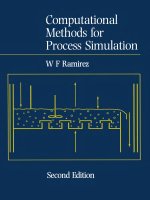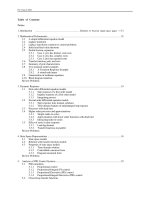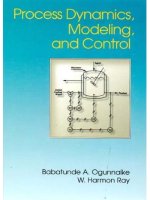computational methods in chemical engineering with maple
Bạn đang xem bản rút gọn của tài liệu. Xem và tải ngay bản đầy đủ của tài liệu tại đây (19.9 MB, 871 trang )
Computational Methods in Chemical Engineering
with Maple
Ralph E. White and Venkat R. Subramanian
Computational Methods in
Chemical Engineering with
Maple
ABC
Prof. Dr. Ralph E. White
University of South Carolina
Dept. Chemical Engineering
Columbia SC 29208
3 C 15 Swearingen Eng. Bldg.
USA
E-mail:
Dr. Venkat R. Subramanian
Associate Professor
Department of Energy Environmental &
Chemical Engineering
Washington University in Saint Louis
One Brookings Drive, Box 1180
Saint Louis, MO 63130
USA
E-mail:
ISBN 978-3-642-04310-9 e-ISBN 978-3-642-04311-6
DOI 10.1007/978-3-642-04311-6
Library of Congress Control Number: 2009940124
c
2010 Springer-Verlag Berlin Heidelberg
This work is subject to copyright. All rights are reserved, whether the whole or part of the mate-
rial is concerned, specifically the rights of translation, reprinting, reuse of illustrations, recitation,
broadcasting, reproduction on microfilm or in any other way, and storage in data banks. Dupli-
cation of this publication or parts thereof is permitted only under the provisions of the German
Copyright Law of September 9, 1965, in its current version, and permission for use must always
be obtained from Springer. Violations are liable to prosecution under the German Copyright Law.
The use of general descriptive names, registered names, trademarks, etc. in this publication does
not imply, even in the absence of a specific statement, that such names are exempt from the relevant
protective laws and regulations and therefore free for general use.
Typesetting: Scientific Publishing Services Pvt. Ltd., Chennai, India
Cover Design: WMX Design, Heidelberg, Germany
Printed in acid-free paper
987654321
springer.com
Preface
This book presents Maple solutions to a wide range of problems relevant to
chemical engineers and others. Many of these solutions use Maple’s symbolic
capability to help bridge the gap between analytical and numerical solutions. The
readers are strongly encouraged to refer to the references included in the book for
a better understanding of the physics involved, and for the mathematical analysis.
This book was written for a senior undergraduate or a first year graduate
student course in chemical engineering. Most of the examples in this book were
done in Maple 10. However, the codes should run in the most recent version of
Maple. We strongly encourage the readers to use the classic worksheet (*.mws)
option in Maple as we believe it is more user-friendly and robust.
In chapter one you will find an introduction to Maple which includes simple
basics as a convenience for the reader such as plotting, solving linear and
nonlinear equations, Laplace transformations, matrix operations, ‘do loop,’ and
‘while loop.’ Chapter two presents linear ordinary differential equations in section
1 to include homogeneous and nonhomogeneous ODEs, solving systems of ODEs
using the matrix exponential and Laplace transform method. In section two of
chapter two, nonlinear ordinary differential equations are presented and include
simultaneous series reactions, solving nonlinear ODEs with Maple’s ‘dsolve’
command, stop conditions, differential algebraic equations, and steady state
solutions. Chapter three addresses boundary value problems. Section one of
chapter three discusses the matrix exponential method in solving linear and
nonlinear boundary value problems, semi-infinite domains, the matrizant method,
and has examples of heat transfer in a fin, cylindrical and spherical catalyst pellet.
Chapter three’s section two discusses nonlinear boundary value problems and
includes series solutions for diffusion of a second order reaction, multiple steady
states, finite difference solutions for nonlinear boundary value problems, shooting
technique for nonlinear boundary problem, and eigenvalue problems, and includes
examples of nonlinear heat transfer, multiple steady states in a catalyst pellet,
Blasius equation in an infinite domain, diffusion with a second order reaction, the
Graetz problem using the finite difference method and the shooting technique. In
chapter four you will find solution techniques for partial differential equations in
semi-infinite domains in semi-infinite domains, Laplace transform, similarity
solution techniques for Parabolic and elliptical PDEs as well as nonlinear partial
differential equations. Some examples found in chapter four are for heat
VI Preface
conduction in a rectangular slab, heat conduction with transient boundary
conditions, heat conduction with radiation at the surface and plane flow past a flat
plate, the Blasius equation. Chapter five presents the method of lines for parabolic
partial differential equations and has two sections. Section one discusses the
semianalytical method for parabolic partial differential equations and section two
discusses the numerical method of lines for parabolic partial differential equations.
Section one has some examples which include a semianalytical method for heat
conduction in a rectangular slab, nonhomogeneous, partial differential equations,
the Graetz problem, composite domains, and the calculation of an exponential
matrix. Section two includes examples for diffusion with second order reaction,
variable diffusivity, nonlinear radiation at the surface, stiff nonlinear partial
differential equations, exothermal reaction in a sphere, etc. Chapter six contains
semianalytical and numerical methods of lines for elliptical partial differential
equations and includes several examples. Some of the examples are heat transfer
in a rectangle, the Graetz problem with a fixed wall temperature, nonlinear
radiation boundary condition, numerical solution for heat transfer for nonlinear
elliptic partial differential equations. In chapter seven, you find a discussion of
partial differential equations in finite domains. Some of the examples include
separation of variables for heat conduction in a rectangle, heat conduction with an
insulator boundary condition, separation of variables for heat conduction in a
rectangle with an initial profile, diffusion with a reaction, and numerical
separation of variable for diffusion in a cylinder. Chapter nine discusses
parameter estimation and includes the least squares method, confidence intervals,
nonlinear least squares, a one parameter model and a two parameter model.
Chapter ten contains miscellaneous topics on numerical methods some of the
examples include a finite difference solution for boundary values problems, and
elliptical partial differential equations, etc.
Acknowledgements
The authors would like to thank Sandra Knotts and Long Cai for their editorial
assistance.
This book is dedicated to my wife, Marjorie, and our four children (Robert,
Priscilla, Lillian, and Samuel). Ralph E. White
This book is dedicated to my wife Gomathi, daughter Anupama and parents
Subramanian and Suriaprabha. Venkat R. Subramanian
Contents
Contents
1 Introduction……………………………………………………………………… 1
1.1 Introduction to Maple 1
1.1.1 Getting Started with Maple 1
1.1.2 Plotting with Maple 3
1.1.3 Solving Linear and Nonlinear Equations 5
1.1.4 Matrix Operations 6
1.1.5 Differential Equations 11
1.1.6 Laplace Transformations 16
1.1.7 Do Loop 18
1.1.8 While Loop 19
1.1.9 Write Data Out Example 19
1.1.10 Reading in Data from a Text File 23
1.1.11 Summary 24
1.1.12 Problems 24
References 27
2 Initial Value Problems
…………………………………………………………29
2.1 Linear Ordinary Differential Equations 29
2.1.1 Introduction 29
2.1.2 Homogeneous Linear ODEs……………………………………29
2.1.3 First Order Irreversible Series Reactions…………………… 31
Example 2.1. Irreversible Series Reactions
(see equations (2.8)) 32
2.1.4 First Order Reversible Series Reactions 37
Example 2.2. Reversible Series Reactions
(see equations (2.10)) 38
2.1.5 Nonhomogeneous Linear ODEs 47
Example 2.3. Heating of Fluid in a Series of Tanks 49
Example 2.4. Time Varying Input to a CSTR with a Series
Reaction 56
2.1.6 Higher Order Linear Ordinary Differential Equations 63
VIII Contents
Example 2.5 A Second Order ODE 65
2.1.7 Solving Systems of ODEs Using the Laplace Transform
Method 72
Example 2.6. Laplace Solution of Example 2.1 Equations 73
Example 2.7. Laplace Solution for Second Order System with
Dirac forcing Function 76
2.1.8 Solving Linear ODEs Using Maple’s ‘dsolve’ Command…….80
Example 2.8. Solving Linear ODEs Using Maple 80
Example 2.9. Heat Transfer in a Series of Tanks, 'dsolve' 81
2.1.9 Summary 83
2.1.10 Problems 84
2.2 Nonlinear Ordinary Differential Equations 87
2.2.1 Introduction 87
Example 2.2.1. Simultaneous Series Reactions 88
2.2.2 Solving Nonlinear ODEs Using Maple’s ‘dsolve’
Command 94
2.2.3 Series Solutions for Nonlinear ODEs 98
Example 2.2.2. Fermentation Kinetics 99
Example 2.2.3 101
2.2.4 Stop Conditions 103
Example 2.2.4. Stop Conditions 103
2.2.5 Stiff ODEs 107
Example 2.2.5. Stiff Ordinary Differential Equations 107
2.2.6 Differential Algebraic Equations 112
Example 2.2.6. Differential Algebraic Equations 112
2.2.7 Multiple Steady States 116
Example 2.2.7. Multiple Steady States 117
2.2.8 Steady State Solutions 124
Example 2.2.8. Steady State Solutions 124
Example 2.2.9. Phase Plane Analysis 139
2.2.9 Summary 148
2.2.10 Problems 149
Appendix A: Matrix Exponential Method 155
Appendix B: Matrix Exponential by the Laplace Transform
Method…………………………………………………161
References 167
3 Boundary Value Problems
…………………………………………… 169
3.1 Linear Boundary Value Problems………………………………… 169
3.1.1 Introduction 169
3.1.2 Exponential Matrix Method for Linear Boundary Value
Problems 169
Example 3.1 171
Example 3.2 175
3.1.3 Exponential Matrix Method for Linear BVPs with
Semi-infinite Domains 180
Contents IX
Example 3.3 181
3.1.4 Use of Matrizant in Solving Boundary Value Problems 184
Example 3.4 185
Example 3.5 187
Example 3.6 189
3.1.5 Symbolic Finite Difference Solutions for Linear Boundary
Value Problems 195
Example 3.7 196
Example 3.8. Cylindrical Catalyst Pellet 203
3.1.6 Solving Linear Boundary Value Problems Using Maple’s
'dsolve' Command 208
Example 3.9. Heat Transfer in a Fin 208
Example 3.10. Cylindrical Catalyst Pellet 209
Example 3.11. Spherical Catalyst Pellet 210
3.1.7 Summary 212
3.1.8 Exercise Problems 213
3.2 Nonlinear Boundary Value Problems 217
3.2.1 Introduction 217
3.2.2 Series Solutions for Nonlinear Boundary Value Problems 218
Example 3.2.1. Series Solutions for Diffusion with a
Second Order Reaction 218
Example 3.2.2. Series Solutions for Non-isothermal Catalyst
Pellet – Multiple Steady States 223
3.2.3 Finite Difference Solutions for Nonlinear Boundary Value
Problems 229
Example 3.2.3. Diffusion with a Second Order Reaction 229
3.2.4 Shooting Technique for Boundary Value Problem 233
Example 3.2.4. Nonlinear Heat Transfer 233
Example 3.2.5. Multiple Steady States in a Catalyst Pellet 238
3.2.5 Numerical Solution for Boundary Value Problems Using
Maple’s 'dsolve' Command 244
Example 3.2.6. Diffusion with Second Order Reaction 245
Example 3.2.7. Heat Transfer with Nonlinear Radiation
Boundary Conditions 247
Example 3.2.8. Diffusion of a Substrate in an Enzyme
Catalyzed Reaction – BVPs with Removable
Singularity 250
Example 3.2.9. Multiple Steady States in a Catalyst Pellet 253
Example 3.2.10. Blasius Equation – Infinite Domains 256
3.2.6 Numerical Solution for Coupled BVPs Using Maple’s 'dsolve'
Command 259
Example 3.2.11. Axial Conduction and Diffusion in a
Tubular Reactor 259
3.2.7 Solving Boundary Value Problems and Initial Value
Problems 262
Example 3.2.12. Diffusion with a Second Order Reaction 262
X Contents
3.2.8 Multiple Steady States 266
Example 3.2.13. Multiple Steady States in a Catalyst
Pellet - η vs. Φ 266
3.2.9 Eigenvalue Problems 272
Example 3.2.14. Graetz Problem–Finite Difference
Solution 272
Example 3.2.15. Graetz Problem–Shooting Technique 278
3.2.10 Summary 286
3.2.11 Exercise Problems 288
References 293
4 Partial Differential Equations in Semi-infinite Domains
……………… 295
4.1 Partial Differential Equations (PDEs) in Semi-infinite Domains 295
4.2 Laplace Transform Technique for Parabolic PDEs 295
Example 4.1. Heat Conduction in a Rectangular Slab 296
Example 4.2. Heat Conduction with Transient Boundary
Conditions 301
Example 4.3. Heat Conduction with Flux Boundary Conditions 305
Example 4.4. Heat Conduction with an Initial Profile 308
Example 4.5. Heat Conduction with a Source Term 311
4.3 Laplace Transform Technique for Parabolic PDEs – Advanced
Problems 314
Example 4.6. Heat Conduction with Radiation at the Surface 314
Example 4.7. Unsteady State Diffusion with a First-Order
Reaction 318
4.4 Similarity Solution Technique for Parabolic PDEs 324
Example 4.8. Heat Conduction in a Rectangular Slab 325
Example 4.9. Laminar Flow in a CVD Reactor 328
4.5 Similarity Solution Technique for Elliptic Partial Differential
Equations 333
Example 4.10. Steady State Heat Conduction in a Plate 333
Example 4.11. Current Distribution in an Electrochemical Cell 336
4.6 Similarity Solution Technique for Nonlinear Partial Differential
Equations 339
Example 4.12. Variable Diffusivity 340
Example 4.13. Plane Flow Past a Flat Plate – Blassius Equation 342
4.7 Summary 348
4.8 Exercise Problems 348
References 352
5 Method of Lines for Parabolic Partial Differential Equations
………353
5.1 Semianalytical Method for Parabolic Partial Differential Equations
(PDEs) 353
5.1.1 Introduction 353
5.1.2 Semianalytical Method for Homogeneous PDEs 353
Example 5.1. Heat Conduction in a Rectangular Slab 356
Contents XI
5.1.3 Semianalytical Method for Nonhomogeneous PDEs 365
Example 5.2 366
Example 5.3 374
Example 5.4 382
Example 5.5 390
Example 5.6. Semianalytical Method for the Graetz
Problem……………………… ………………401
Example 5.7. Semianalytical Method for PDEs with Known
Initial Profiles 414
5.1.4 Semianalytical Method for PDEs in Composite Domains 425
Example 5.8 425
5.1.5 Expediting the Calculation of Exponential Matrix 437
Example 5.9 438
Example 5.10 442
Example 5.11 448
5.1.6 Summary 451
5.1.7 Exercise Problems 452
5.2 Numerical Method of Lines for Parabolic Partial Differential
Equations (PDEs) 456
5.2.1 Introduction 456
5.2.2 Numerical Method of Lines for Parabolic PDEs with
Linear 456
Example 5.2.1. Diffusion with Second Order Reaction 458
Example 5.2.2. Variable Diffusivity 464
5.2.3 Numerical Method of Lines for Parabolic PDEs with
Nonlinear Boundary 469
Example 5.2.3. Nonlinear Radiation at the Surface 470
5.2.4 Numerical Method of Lines for Stiff Nonlinear PDEs 474
Example 5.2.4. Exothermal Reaction in a Sphere 474
5.2.5 Numerical Method of Lines for Nonlinear Coupled PDEs 480
Example 5.2.5. Two Coupled PDEs 480
5.2.6 Numerical Method of Lines for Moving Boundary
Problems 491
Example 5.2.6. The Shrinking Core Model for Catalyst
Regeneration 491
5.2.7 Summary 501
5.2.8 Exercise Problems 502
References 505
6 Method of Lines for Elliptic Partial Differential Equations………….507
6.1 Semianalytical and Numerical Method of Lines for Elliptic PDEs 507
6.1.1 Introduction 507
6.1.2 Semianalytical Method for Elliptic PDEs in Rectangular
Coordinates 507
Example 6.1. Heat Transfer in a Rectangle 508
Example 6.2 520
XII Contents
6.1.3 Semianalytical Method for Elliptic PDEs in Cylindrical
Coordinates – Graetz Problem 536
Example 6.3. Graetz Problem with a Fixed Wall
Temperature 536
6.1.4 Semianalytical Method for Elliptic PDEs with Nonlinear
Boundary Conditions 547
Example 6.4. Nonlinear Radiation Boundary Condition 547
6.1.5 Semianalytical Method for Elliptic PDEs with Irregular
Shapes 556
Example 6.5. Potential Distribution in a Hull Cell 556
6.1.6 Numerical Method of Lines for Elliptic PDEs in
Rectangular Coordinates 564
Example 6.6. Numerical Solution for Heat Transfer in a
Rectangle 565
Example 6.7. Numerical Solution for Heat Transfer for
Nonlinear Elliptic PDEs 573
6.1.7 Summary 581
References 585
7 Partial Differential Equations in Finite Domains
…………… …………587
7.1 Separation of Variables Method for Partial Differential Equations
(PDEs) in Finite Domains 587
7.1.1 Introduction 587
7.1.2 Separation of Variables for Parabolic PDEs with
Homogeneous Boundary Conditions 587
Example 7.1. Heat Conduction in a Rectangle 587
Example 7.2. Heat Conduction with an Insulator Boundary
Condition 599
Example 7.3. Mass Transfer in a Spherical Pellet 604
7.1.3 Separation of Variables for Parabolic PDEs with an Initial
Profile 609
Example 7.4. Heat Conduction in a rectangle with an Initial
Profile 609
Example 7.5. Heat Conduction in a Slab with a Linear Initial
Profile 613
7.1.4 Separation of Variables for Parabolic PDEs with Eigenvalues
Governed by Transcendental Equations 618
Example 7.6. Heat Conduction in a Slab with Radiation
Boundary Conditions 618
7.1.5 Separation of Variables for Parabolic PDEs with
Nonhomogeneous Boundary Conditions 623
Example 7.7. Heat Conduction in a slab with
Nonhomogeneous Boundary Conditions 623
Example 7.8. Diffusion with Reaction 629
7.1.6 Separation of Variables for Parabolic PDEs with Two
Flux Boundary Conditions 635
Contents XIII
Example 7.9. Diffusion in a Slab with Nonhomogeneous
Flux Boundary Conditions 635
7.1.7 Numerical Separation of Variables for Parabolic PDEs 643
Example 7.10. Heat Transfer in a Rectangle 643
7.1.8 Separation of Variables for Elliptic PDEs 649
Example 7.11. Heat Transfer in a Rectangle 649
Example 7.12. Diffusion in a Cylinder 655
Example 7.13. Heat Transfer with Nonhomogeneous
Boundary Conditions 660
Example 7.14. Heat Transfer with a Nonhomogeneous
Governing Equation 667
7.1.9 Summary 672
7.1.10 Exercise Problems 672
References ……………… 678
8 Laplace Transform Technique for Partial Differential Equations
……679
8.1 Laplace Transform Technique for Partial Differential Equations
(PDEs) in Finite Domains 679
8.1.1 Introduction 679
8.1.2 Laplace Transform Technique for Hyperbolic PDEs 679
Example 8.1. Wave Propagation in a Rectangle 679
Example 8.2. Wave Propagation in a Rectangle 682
8.1.3 Laplace Transform Technique for Parabolic Partial
Differential Equations – Simple Solutions 685
Example 8.3. Heat Transfer in a Rectangle 685
Example 8.4. Transient Heat Transfer in a Rectangle 688
8.1.4 Laplace Transform Technique for Parabolic Partial
Differential Equations – Short Time Solution 690
Example 8.5. Heat Transfer in a Rectangle 691
Example 8.6. Mass Transfer in a Spherical Pellet 696
8.1.5 Laplace Transform Technique for Parabolic Partial
Differential Equations – Long Time Solution 701
Example 8.7. Heat Conduction with an Insulator Boundary
Condition 703
Example 8.8. Diffusion with Reaction 709
Example 8.9. Heat Conduction with Time Dependent
Boundary Conditions 714
8.1.6 Laplace Transform Technique for Parabolic Partial
Differential Equations – Heaviside Expansion Theorem for
Multiple Roots 719
Example 8.10. Heat Transfer in a Rectangle 720
Example 8.11. Diffusion in a Slab with Nonhomogeneous
Flux Boundary Conditions during Charging
of a Battery 725
Example 8.12. Distribution of Overpotential in a Porous
Electrode 729
XIV Contents
Example 8.13. Heat Conduction in a Slab with Radiation
Boundary Conditions 736
8.1.7 Laplace Transform Technique for Parabolic Partial
Differential Equations in Cylindrical Coordinates 742
Example 8.14. Heat Conduction in a Cylinder 742
8.1.8 Laplace Transform Technique for Parabolic Partial
Differential Equations for Time Dependent Boundary
Conditions – Use of Convolution Theorem 747
Example 8.15. Heat Conduction in a Rectangle with a
Time Dependent Boundary Condition 748
8.1.9 Summary 755
8.1.10 Exercise Problems 755
References 760
9 Parameter Estimation…………………… ……………………………761
9.1 Introduction 761
9.2 Least Squares Method 762
9.2.1 Summation Form or Classical Form 769
9.2.2 Confidence Intervals: Classical Approach 775
9.2.3 Prediction of New Observations 776
9.2.4 A One Parameter through the Origin Model 777
9.3 Nonlinear Least Squares 778
Example 9.1. Parameter Estimation 783
9.4 Hessian Matrix Approach 789
9.5 Confidence Intervals 795
9.6 Sensitivity Coefficient Equations 797
9.7 One Parameter Model 807
9.8 Two Parameter Model 812
9.9 Exercise Problems 819
References 819
10 Miscellaneous Topics ………………………………………………… 821
10.1 Miscellaneous Topics on Numerical Methods 821
10.1.1 Introduction 821
10.1.2 Iterative Finite Difference Solution for Boundary
Value Problems 821
Example 10.1. Diffusion with a Second Order Reaction… 821
Example 10.2. Nonisothermal Reaction in a
Catalyst Pellet – Multiple Steady States 825
10.1.3 Finite Difference Solution for Elliptic PDEs 827
Example 10.3. Heat Transfer in a Rectangle 827
Example 10.4. Heat Transfer in a Cylinder 832
10.1.4 Iterative Finite Difference Solution for Elliptic PDEs 833
Example 10.5. Heat Transfer in a Rectangle – Nonlinear
Elliptic PDE 833
Contents XV
10.1.5 Numerical Method of Lines for First Order Hyperbolic
PDEs 838
Example 10.6. Wave Propagation in a Rectangle with
Consistent Initial/Boundary Conditions. 839
Example 10.7. Wave Propagation in a Rectangle with
inconsistent Initial/Boundary Conditions 844
10.1.6 Numerical Method of Lines for Second Order
Hyperbolic PDEs 848
Example 10.8. Wave Equation with Consistent
Initial/Boundary Conditions 848
Example 10.9. Wave Equation with Inconsistent
Initial/Boundary Conditions 852
10.1.7 Summary 855
10.1.8 Exercise Problems 855
References 856
Subject Index
………………………………………………………………………….857
Chapter 1
Introduction
1.1 Introduction to Maple
1.1.1 Getting Started with Maple
Some Maple basics are presented in this chapter as a convenience for the reader.
Two Maple books[1, 2] that have proven to be useful are given as references 1 and
2 at the end of this chapter. Maple can be started either from the shortcut on the
desktop or from Start → Programs → Maple 12. This opens a new Maple
worksheet in the Maple environment. You should usually type ‘restart’ as the first
command in your Maple worksheets.
> restart;
This restart command clears all the stored variables and restarts the worksheet
every time it is executed.
Numerical values can be assigned to variables in Maple by using the characters
‘:= after x, for example. That is, to assign the value 2 to the variable x, the colon
and equal sign ‘:=’ characters are used together. You can use the # sign to add
comments
> x:=2; # an assignment statement.
:=
x
2
Note that ‘:=’ is the assignment operator which assigns an expression or number
(2) to a variable named x. If the colon is not used, the value is not assigned. For
example, 2 is not assigned to y by using ‘=’ only. For example, type
> y=2;
= y 2
Now type both x and y to see their values.
> x;
2
> y;
y
2 1 Introduction
This shows that ‘:=’ assigned the value 2 to x whereas ‘=’ did not assign 2 to y.
One can use Maple to do numerical and symbolic calculations. A few examples
are shown next.
> x^2;
4
> x^2.;
4.
> sqrt(x);
2
> x^0.5;
1.414213562
> abs(x);
2
> -x;
-2
> x+y;
−+2y
> abs(-2);
2
The imaginary number −1 is designated as I in Maple:
> (-1)^(1/2);
I
The Maple command ‘evalf’ provides numeric evaluation and the ‘eval’ command
yields a symbolic evaluation:
> evalf(sqrt(2));
1.414213562
> eval(sqrt(2));
2
Symbolic variables can also be assigned to names as follows:
> z:=y;
:= zy
> z;
y
1.1 Introduction to Maple 3
Differentiation can be done by using the ‘diff’ command:
> diff(y,y);
1
> diff(y^2,y);
2 y
Integration can be done by using the ‘int’ command:
> int(y,y);
y
2
2
Maple can also do definite integration:
> int(y,y=0 1);
1
2
1.1.2 Plotting with Maple
Plots can be made in Maple using the ‘plot’ command:
> plot(y,y=0 1);
y
Fig. 1.1 Maple plot of y = y
4 1 Introduction
> plot(y^2,y=0 1);
y
2
Fig. 1.2 Maple plot of y
2
= y
To plot both curves on the same graph in a box use the following command.
> plot([y,y^2],y=0 1,axes=boxed);
y and y
2
Fig. 1.3 Maple plot of y and y
2
vs y
1.1 Introduction to Maple 5
1.1.3 Solving Linear and Nonlinear Equations
One can solve equations in Maple using the ‘solve’ and ‘fsolve’ commands. The
‘solve’ command is used to solve linear equations in symbolic form and the
‘fsolve’ command is used to solve linear and nonlinear equations numerically.
For example,
> restart:
> eq:=x+2;
:= eq +
x
2
> solve(eq);
-2
Maple can solve equations in symbolic form also:
> eq:=x-a;
:= eq −
x
a
> solve(eq);
{},= a
x
=
x
x
This solution says that either x = x or a = x. To solve specifically for x
> solve(eq,x);
a
Note that a has not been assigned to x which can by seen by typing x:
> x;
x
One can assign the value of a to x by solving the above equation for x:
> eq:=x-a;
=−eq : x a
> x:=solve(eq,x);
=x: a
One can use the ‘fsolve’ command in Maple to solve equations numerically:
> eq1:=y+1;
:= eq1 + y 1
> fsolve(eq1,y);
-1.
Note that ‘fsolve’ returns a floating point number with a decimal point.
6 1 Introduction
Two or more nonlinear equations can be solved by using ‘fsolve’. For example,
consider finding the solutions (x and y) for the following two equations.
> restart:
> eq1:=x+tan(y)=1;
:= eq1 = +
x
()tan y 1
> eq2:=y^2+tan(x)=1;
:= eq2 = + y
2
()tan x 1
> fsolve({eq1,eq2},{x,y});
{}, =
x
-3.858064894 = y 1.367788596
One can find other solutions to these equations by restricting the ranges of x and y:
> fsolve(f#,{x=1 3,y=1 3});
{}, =
x
1.760535729 = y 2.491382707
1.1.4 Matrix Operations
Maple has a package for solving linear algebra problems which can be called by
using the ‘with(linalg)’ command.
> restart:
> with(linalg):
Warning, the protected names norm and trace have been redefined and unprotected.
Maple is capable of doing a variety of matrix operations. For example, let A
and B be 2 x 2 matrices which can be entered as follows:
> A:=matrix(2,2,[1,2,3,4]);
:= A
⎡
⎣
⎢
⎢
⎤
⎦
⎥
⎥
12
34
> B:=matrix(2,2,[1,1,3,2]);
:= B
⎡
⎣
⎢
⎢
⎤
⎦
⎥
⎥
11
32
Use the ‘evalm’ command to perform matrix operations. For example, matrix
addition and subtraction can be done:
> evalm(A+B);
⎡
⎣
⎢
⎢
⎤
⎦
⎥
⎥
23
66
1.1 Introduction to Maple 7
> evalm(A-B);
⎡
⎣
⎢
⎢
⎤
⎦
⎥
⎥
01
02
Multiplication of matrices requires using evalm and ‘&*’:
> evalm(A&*B);
⎡
⎣
⎢
⎢
⎤
⎦
⎥
⎥
75
15 11
The determinant of a matrix can be found by using ‘det’:
> det(A);
-2
and
> det(B);
-1
Matrices can be inverted by using the ‘inverse command’:
> inverse(A);
⎡
⎣
⎢
⎢
⎢
⎢
⎢
⎤
⎦
⎥
⎥
⎥
⎥
⎥
-2 1
3
2
-1
2
> inverse(inverse(A));
⎡
⎣
⎢
⎢
⎤
⎦
⎥
⎥
12
34
The transpose of a matrix can be obtained also
> transpose(A);
⎡
⎣
⎢
⎢
⎤
⎦
⎥
⎥
13
24
A particular element of a matrix can be printed easily:
> A[1,1];
1
8 1 Introduction
A matrix can be raised to a power by using the ‘evalm’ command:
> evalm(A^2);
⎡
⎣
⎢
⎢
⎤
⎦
⎥
⎥
710
15 22
The characteristic polynomial, eigenvalues, and eigenvectors of a matrix can be
obtained as follows:
> charpoly(A,lambda);
− − λ
2
5 λ 2
> eigenvalues(A);
, +
5
2
33
2
−
5
2
33
2
> eigenvectors(A);
,
⎡
⎣
⎢
⎢
⎤
⎦
⎥
⎥
,, +
5
2
33
2
1{ }
⎡
⎣
⎢
⎢
⎤
⎦
⎥
⎥
,1 +
3
4
33
4
⎡
⎣
⎢
⎢
⎤
⎦
⎥
⎥
,, −
5
2
33
2
1{ }
⎡
⎣
⎢
⎢
⎤
⎦
⎥
⎥
,1 −
3
4
33
4
or
> eigenvects(A);
,
⎡
⎣
⎢
⎢
⎤
⎦
⎥
⎥
,, +
5
2
33
2
1{ }
⎡
⎣
⎢
⎢
⎤
⎦
⎥
⎥
,1 +
3
4
33
4
⎡
⎣
⎢
⎢
⎤
⎦
⎥
⎥
,, −
5
2
33
2
1{ }
⎡
⎣
⎢
⎢
⎤
⎦
⎥
⎥
,1 −
3
4
33
4
Matrices can be raised to various powers and added. For example, let
> eq:=A+A^2+A^3;
:= eq + + AA
2
A
3
> evalm(eq);
⎡
⎣
⎢
⎢
⎤
⎦
⎥
⎥
45 66
99 144
Maple’s ‘Id’ command can be used to generate an identity matrix:
> Id:=band([1],2);
:= Id
⎡
⎣
⎢
⎢
⎤
⎦
⎥
⎥
10
01
1.1 Introduction to Maple 9
Elements of a matrix can be in symbolic form and a variety of matrix operations
can be performed:
> A:=matrix(2,2,[a,b,c,d]);
:= A
⎡
⎣
⎢
⎢
⎤
⎦
⎥
⎥
ab
cd
> transpose(A);
⎡
⎣
⎢
⎢
⎤
⎦
⎥
⎥
ac
bd
> inverse(A);
⎡
⎣
⎢
⎢
⎢
⎢
⎢
⎢
⎢
⎤
⎦
⎥
⎥
⎥
⎥
⎥
⎥
⎥
d
− ad bc
−
b
− ad bc
−
c
− ad bc
a
− ad bc
> evalm(A&*B);
⎡
⎣
⎢
⎢
⎤
⎦
⎥
⎥
+ a 3 b + a 2 b
+ c 3 d + c 2 d
A matrix can be multiplied with a scalar:
> evalm(2*A);
⎡
⎣
⎢
⎢
⎤
⎦
⎥
⎥
2 a 2 b
2 c 2 d
Eigenvalues can be obtained:
> eigenvalues(A);
, + +
a
2
d
2
− + + a
2
2 ad d
2
4 bc
2
+ −
a
2
d
2
− + + a
2
2 ad d
2
4 bc
2
Eigenvectors can be obtained:
> eigenvects(A);
⎡
⎣
⎢
⎢
⎢
⎢
⎢
⎤
⎦
⎥
⎥
⎥
⎥
⎥
,, + +
a
2
d
2
− + + a
2
2 ad d
2
4 bc
2
1
⎧
⎩
⎪
⎪
⎪
⎪
⎪
⎨
⎫
⎭
⎪
⎪
⎪
⎪
⎪
⎬
⎡
⎣
⎢
⎢
⎢
⎢
⎢
⎤
⎦
⎥
⎥
⎥
⎥
⎥
,−
− + −
a
2
d
2
− + + a
2
2 ad d
2
4 bc
2
c
1
⎡
⎣
⎢
⎢
⎢
⎢
⎢
,
,, + −
a
2
d
2
− + + a
2
2 ad d
2
4 bc
2
1
⎧
⎩
⎪
⎪
⎪
⎪
⎪
⎨
⎫
⎭
⎪
⎪
⎪
⎪
⎪
⎬
⎡
⎣
⎢
⎢
⎢
⎢
⎢
⎤
⎦
⎥
⎥
⎥
⎥
⎥
,−
− + +
a
2
d
2
− + + a
2
2 ad d
2
4 bc
2
c
1
⎤
⎦
⎥
⎥
⎥
⎥
⎥
10 1 Introduction
The exponential matrix of a matrix can be obtained as follows:
> exponential(B,t);
+ − +
1
2
e
⎛
⎝
⎜
⎜
⎞
⎠
⎟
⎟
t () + 3 13
2
1
26
13 e
⎛
⎝
⎜
⎜
⎞
⎠
⎟
⎟
−
t ()−+ 3 13
2
1
26
13 e
⎛
⎝
⎜
⎜
⎞
⎠
⎟
⎟
t ()+ 3 13
2
1
2
e
⎛
⎝
⎜
⎜
⎞
⎠
⎟
⎟
−
t ()− + 3 13
2
⎡
⎣
⎢
⎢
⎢⎢
,
− +
1
13
13 e
⎛
⎝
⎜
⎜
⎞
⎠
⎟
⎟
−
t ()− + 3 13
2
1
13
13 e
⎛
⎝
⎜
⎜
⎞
⎠
⎟
⎟
t () + 3 13
2
⎤
⎦
⎥
⎥
⎥
⎥
− +
3
13
13 e
⎛
⎝
⎜
⎜
⎞
⎠
⎟
⎟
−
t ()− + 3 13
2
3
13
13 e
⎛
⎝
⎜
⎜
⎞
⎠
⎟
⎟
t ()+ 3 13
2
⎡
⎣
⎢
⎢
⎢
⎢
,
− + +
1
2
e
⎛
⎝
⎜
⎜
⎞
⎠
⎟
⎟
t () + 3 13
2
1
26
13 e
⎛
⎝
⎜
⎜
⎞
⎠
⎟
⎟
−
t ()− + 3 13
2
1
26
13 e
⎛
⎝
⎜
⎜
⎞
⎠
⎟
⎟
t () + 3 13
2
1
2
e
⎛
⎝
⎜
⎜
⎞
⎠
⎟
⎟
−
t ()− + 3 13
2
⎤
⎦
⎥
⎥
⎥⎥
The ‘map’ command can be used to differentiate and integrate each element in a
matrix:
> A:=matrix(2,2,[x,a*x,1/x,c]);
:= A
⎡
⎣
⎢
⎢
⎢
⎢
⎢
⎤
⎦
⎥
⎥
⎥
⎥
⎥
x
a
x
1
x
c
> map(diff,A,x);
⎡
⎣
⎢
⎢
⎢
⎢
⎢
⎤
⎦
⎥
⎥
⎥
⎥
⎥
1 a
−
1
x
2
0
> map(int,A,x);
⎡
⎣
⎢
⎢
⎢
⎢
⎢
⎤
⎦
⎥
⎥
⎥
⎥
⎥
x
2
2
ax
2
2
()ln xcx
> map(int,A,x=0 1);
⎡
⎣
⎢
⎢
⎢
⎢
⎢
⎤
⎦
⎥
⎥
⎥
⎥
⎥
1
2
a
2
∞ c









